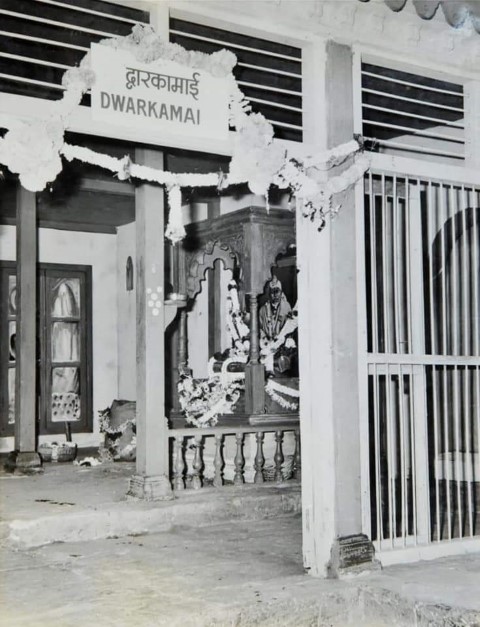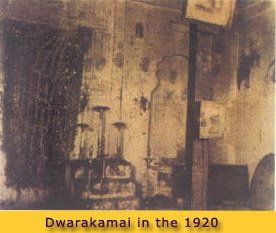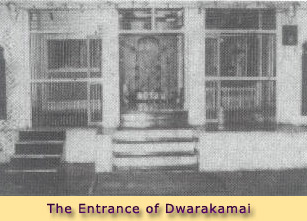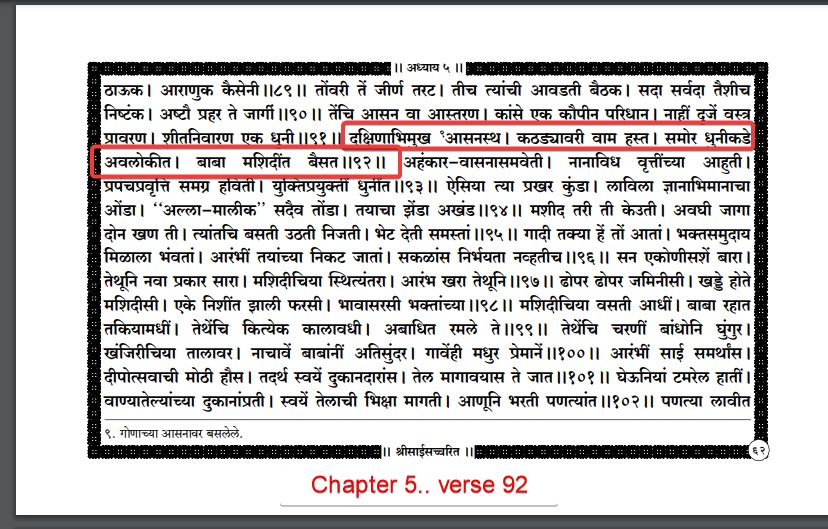DWARAKAMAI (MASJID) |
||
WHY DWARAKAMAI? "This is our Dwarakamai where you are sitting. She wards off all dangers and anxieties of the children who sit on her lap". “Mashidimayee is her name. Will she ever go back on her promise?” said Baba to Bala Saheb Mirikar who was going to Chitali, and was to have an encounter with a serpent (Ref. ESS, XXII). A Mother is always full of love and tenderly merciful towards her child. Mashid or Ma+Shi+da means refuge at the feet of Lord Shiva. In Shirdi the Parabrahma gave refuge and is still giving refuge to the multitudes of devotees that flock there. The word Dwaraka can be broken into Dwar+Ka. Dwar means the door and Ka means Brahman. Thus, it is the door or the gateway to get to or reach Brahman. Dwaraka is that place where one can get freedom from the bondage of Karmic actions. Dwaraka is also known as Mukthidham and Mokshapuri. It was here that Baba spent 60 years in bliss. Here Baba granted his devotees wishes, and nurtured them like the mother tortoise. Finally, he took Maha Samadhi in his beloved Mashidimayee. Baba's words are always true. Then why did Baba call this Masjid 'Dwarakamai"? One can geographically, historically, mythologically place Dwaraka at Shirdi. 1. The Churning of Kshirsagar The story of churning the Kshirasagar goes like this. It was agreed by the Gods and Demons that whoever accepted the Halahal (poison) was also able to partake of the Ambrosia (Amrit). Lord Shiva drank the Halahal and it was made to stop in His throat. Thus He earned the name "THIRU NEEL KANTESHWAR" and the place of occurrence got the name "GHAT SIRAS" (taluq: Parthardi, SE of Shirdi). After the Halahal, Ambrosia came into creation and the Gods partook of it. Chandra (Moon) and Surya (Sun) came to know that Rahu and Kethu stealthily came to the God's side and partook the Ambrosia. They quickly informed Lord Vishnu about this. Vishnu came in the disguise of the beautiful Mohini and dazzled Rahu and Kethu and then cut the head of Rahu with her golden chakra. The place where Rahu's body was thrown is called Rahuri (about 45 kms from Shirdi) where a temple is said to exist. The place of occurrence is called Mohini Raj (Arda Nari Nateshwar temple at Newasa; 110 km SE of Shirdi). Kethu's bodyless head fell in Kethu temple at Rathangad (60 km NW of Rahuri). The nectar that flowed out of Kethu's mouth at Rathangad became the exalted Parwara river. This river was originally known as Amrit Vahini (carrier of nectar). Out of the 14 Ratnas (jewels), Lord Shiva took Halahal, Ambrosia and Chandra. The place of Chandra is now called Chandgoan (about 130 kms from Shirdi) where Chandreshwar temple is. Lord Krishna took Devi Lakshmi, Kausthab (gold making bell), Shank and Dhanur. Lord Indra took Airavatam, Kamadhenu, Rambha, Parijatham and Dhanvantari (Ashvini Kumar), the place is called Belapur (25 kms from Shirdi). The Bilveshwar Mandir is there. The place of Ashvini Kumar is called Ashvi (20 km from Shirdi). Lord Surya took the seven headed horse and the place is called Kolhar (45 kms from Shirdi).
Spiritual Significance of Shirdi by Dr.Vinny Chitluri - Courtesy: Shri.Nikhil Kripalani 2. The Yadav dynasty As late as 12th and 13Ih century, Yadav (Lord Krishna's dynasty) ruled most of present Maharashtra. Their capital was Devgad Fort near Aurangabad mentioned in the Dhyaneshwari. Rukmini, the wife of Lord Krishna, was born at Kundipur, Amravati district, near Nagpur. Her father ohishmak, was a king and his capital was Devgad near Fort Aurangabad. 3. Pandharpur The southern most tip of Dwaraka is situated in Sholapur district (450 kms from Shirdi). The story of Pundalik is as follows: Once Rukmini left Lord Krishna in a huff. Krishna went after her to pacify her. He roamed the Dhandrivan forest, found and pacified her. On His way He saw Pundalik doing ardent seva to his parents. On seeing the Lord, Pundalik threw a brick and asked Krishna to sit a while, till he had finished. The Lord stood on the brick and waited with astonishment arms akimbo. The Lord was pleased at the selfless seva and said to Pundalik 'ask for a boon'. Pundalik unhesitantly asked the Lord to come and stay at Dhandrivan as Vittal. This He did, and the place is called Pandharpur, southern most tip of Dwaraka. 4. Gopal Kala Lord Krishna practiced Gopal Kala (parched rice mixed with curds etc. in an earthen pot). Baba too mixed all the food in the Kolamba and partook of it and distributed it to all. Gopal Kala is performed by the Sansthan on the completion of all ceremonies at Shirdi. 5. Our Dwarakamai The best explanation is given in English Sai Satcharitra Ch. IV. Definition of Dwaraka quoted from Skanda Purana 'The place where the doors are open for all people regardless of caste, community and creed, for accomplishing Dharma, Artha, Kama, and Moksha is called Dwaraka'-Baba's Masjid in Shirdi is open to one and all. The sanctum sanctorum is closed at about 9 p.m., while the Sabhamandap is left open throughout the night. Before the sanctum sanctorum is closed it is swept and cleaned, a zaari full of water is placed in front of Baba’s photograph, the mosquito net is hung around the photograph and a lit Kandil (lantern) is hung above the Kathada or railing. Lantern Lighting inside the Dwarakamai started in May 1930 (ref: Shirdi Gazetteer). Petromax Light at night time near Baba's photograph inside the Dwarakamai started from May 1933 (ref: Shirdi Gazetteer). In 1996, this Kandil started swinging; many devotees felt that it was an omen, others felt that some great change, or event was about to take place in Shirdi. Many devotees gathered around to behold the event, the place of the Kandil was changed, yet the swinging did not stop. This happened for about a week, the only event that occurred was that Sivanesan Swamiji died on 12th February 1996. He loved the Dwarakamai and from the early 1960’s looked after it with tender and loving care.
What did this Masjid look like? This Masjid that Baba extolled was old and dilapidated. There were deep pits and huge holes in the floor. Each and every nook and corner had garbage dumped in it. It was in this ambience that he stayed, blissfully smoking his Chillim, by day and night. To appease his hunger he took Bhiksha (Alms) from five houses. Whether the food was stale or delicious he did not bother.
Very Old Picture of Dwarakamai Masjid (Courtesy: Hemant Timande)
Photo Courtesy: Shri.Nandakumar Revannath Deshpande Nimonkar On his body were torn and tattered clothes, and it was impossible for the people to recognize his divinity. Often he roamed in the forests nearby. There he would sit under the Babul Tree (a small tree full of thorns), often talking to some unknown entity and waving his hands about in a threatening manner. The villagers saw his lifestyle and took little notice of him. The only time they interacted with him was when someone in the family was sick and they needed some medicines. Baba dispensed his medicines readily. If the patient did not recover quickly, he himself went and nursed him back to health. Baba’s divinity dawned on the villagers only after Nana Saheb Chandorkar’s visits to Shirdi. He was convinced of Baba’s superhuman powers and divinity although, Gangagiri Maharaj had told the villagers “He is a valuable diamond lying in a heap of rubbish. It is your good fortune that he has come to stay amongst you”. The Sadguru manifests to uplift his devotees. His only concern is their welfare in every aspect of life. He is eager that they progress spiritually and that they are filled with love, and bliss. The devotees are also eager to do Guru Seva, charitable deeds, and fulfill his wishes. The Repair of the Masjid Nana Saheb’s heart was bursting with love and devotion. He was eager to renovate and repair the old and dilapidated Masjid. His only thought was “How will I get permission to make the Masjid more habitable?”. Baba However was quite content, and did not grant him permission. Nonetheless with this thought in his mind he went to Shirdi. The next morning Nana was standing outside the Masjid and waiting for Mahalsapati, who had done to get his Bhiksha. Having received it, he was about to enter the Masjid, when Nana accosted him. Nana was eager to tell him of his plan. At that very moment Baba called out to Mahalsapati. Mahalsapti immediately went to Baba, who said, “Arre Bhagat, who is standing outside?”. Mahalsapti told him that it was Nana Saheb Chandorkar. Innocently Baba said, “Is that so? Bhagat I wanted to have your opinion on this matter. That Nana says, “Baba I would like to build a new Masjid”. Now don’t you think our old Masjid is good enough for us?”. To this Mahalsapati replied, “Baba let him build a new Masjid. It will be very useful for both of us, as we will have a place to sit, and to sleep when the time comes”. Then Baba agreed and gave his consent on 20th February 1912 (ref: Shirdi Gezetteer). As soon as Baba gave his consent, Mahalsapati called out to Nana, and asked him to start the work. Nana immediately brought a coconut and broke it. Thus, on Mahalsapati’s advice Nana Saheb Chandorkar was allowed to renovate the Masjid. And Kaka Saheb Dixit was allowed to do the flooring. (Refer “Shiladhi” by Dr.Keshav B Gavankar). The three carpenter brothers Kondaji, Gabaji and Tukaram Sutar provided the greatest help in the repair of Masjid. All the woodwork was done by them. After the renovation the management of the Masjid continued with them for many years. Till Baba’s Mahasamadhi, Tukaram undertook the sweeping of the Masjid. He took care of Baba’s needs like heating water, and giving it to Baba to wash his face and mouth. Baba would not allow any other person to do this. (Refer “Shri Sai Baba of Shirdi” by the Late Rao Bahadur M.W.Pradhan). The Sabhamandap (1911) – Extension of Dwarakamai The area in front of the Dwaraka Mai was a vacant plot. The devotees stood there and attended the Aratis, often in the scorching heat and rain. Dixit thought that if a Sabhamandap or portico was built, then it would provide shelter for the devotees from the elements. He was determined to build it no matter what it cost. Gopal Gund who started the Urs thought that he should repair the Masjid. But that job was for Nana Chandorkar, and the pavement work for Dixit. Permission at first was not granted, but, on the intervention of Mahalsapathi, it was granted. Dixit wanted to extend the space in front of the Masjid so that the devotees could use it. He bought tall iron pillars, and angled brackets. On the day that Baba slept in the Chavadi, he and the other devotees worked all night. The next morning when Baba came to the Dwarakamai Mai he swiftly pulled out the pillars. In 1911 this Sabha Mandap was put in order with great efforts. In Sai Satcharitra, Chapter 6, a detailed account is given under “the renovation of the Masjid and construction of the Sabha Mandap”. An incident is mentioned, how Baba caught hold of one post with one hand and Tatya's neck with the other hand and shook both. Then taking Tatya's pheta He burnt it offering one rupee from His pocket. Seeing this strange behaviour none dared to intervene. After cooling down He brought one beautiful embroidered pheta and Himself tied it on Tatya's head. As if Tatya was being given a special honour. (Ref. ESS, Ch.VI). After this incident Baba allowed the work to go on smoothly and thus the devotees had a place for worshipping Baba. The pavilion is still there where the devotees can see, and participate in the worship of Baba and also touch the sacred articles used by Baba. Thanks to Dixit’s dedication and determination. The devotees now can enjoy its comfort. In this Mandap many Palkhis stop for a while. Devotees use it for exchanging garlands on their weddings, for christening ceremonies and Anna Prashana (the ceremony of solid food being given to the child). But most importantly, devotees recite the Vishnu Sahasranama, Do Baba’s Naam Jap, and read the Sai Satcharitra. Thus, the Dwarakamai Mai had two parts, the Sanctum Sanctorum which is the Masjid or Dwarakamai Mai and the Sabha Mandap. The Sanctum Sanctorum or Dwarakamai Mai faces east. Three steps lead to the inside. The three steps are 17’ in length and 15’ in breadth. The entrance to the Sabha Mandap faces south. The roof has CI corrugated tin sheets. These sheets were donated by Baba’s ardent devotee Capt.Daruwala as a gesture of gratitude. Through his mysterious ways Baba saved him, his crew and some ships from the enemy during the Russo-Japanese war of 1905. The roof is supported by 12 iron pillars, 15’ long, 15 feet high. There are small niches in the eastern wall, seven on the right, and ten on the left, of the shrine that houses Baba’s photograph. In the past, devotees used to place lighted Diyas (earthen lamps) as Baba loved to light Diyas. The length of the Sabha Mandap is about 48’ from the Platform to the Shrine, and the breadth is 38’. There is a room that shares its eastern wall of the Sabha Mandap. Its door faces east. The signboard above it reads, “Shyam Sunder Hall”. This was the school that Shyama taught for six years before he retired. On the western wall a blackboard still remains. Next to it was a window that when opened looked into the Sabha Mantap. Shyama used to sleep in the school and Baba slept alone in the Dwarakamai. Often Shyama could hear Baba talk in English, Parsi, Hindi and various other languages. When Shyama peeped through the window he found Baba alone. This strenghtened his faith in Baba. This school was turned into a stable for Shyam Karan, later it became the Parayan Hall and now is being used to sieve and store Udhi. Dwarakamai in the 1920s Each and every article present in the Dwarakamai fills the devotee’s heart with love, joy and peace. Baba spent 60 years here. His touch has filled every stone, brick and woodwork with life. This is the place where he fondly asked about each devotee’s welfare, and told stories. Like a fond mother he fed the devotees sweets. Sometimes he cut fruits into small pieces and put small morsels into their mouth.
In the place that he sat there was a hug portrait painted by Shamrao R Jaykar that faces the south. Now a copy of that portrait is there, and the original portrait is kept on the first floor of the Museum inside temple complex. This masterpiece is so much famous that it’s often referred to as the Dwarakamai Mai Baba Photograph. Below this portrait was a Chappi (a wet cloth that is wound around the end of the Chillim) and a Chillim. A set of marble Padukas were installed directly in front of the portrait for the devotees to Namaskar. The Nimbar was garlanded daily and draped with a beautiful shawl. Next to it were the three ever burning lamps. The lamps are still there. There were two Grinding Mills next to the lamps. Baba used the Bigger Grinding Mill when he ground wheat to drive away the cholera epidemic that had spread widely in Shirdi village. He used the smaller one to grind pulses, and spices when he wanted to do Annadaan. Beside the lamps was, and still is, a sack filled with wheat. To the left, in the alcove was the clay Maath (water pot). In the corner near the math were a stack of Chillims that are now in the museum. Next to these were Baba’s Bhiksha utensils, like the Tumrel and Kolamba. The Tumrels are now kept in the museum. In front was the open Dhuni Mai. Then a small wall was erected around it and the Dhuni Mai was enclosed. In a cupboard next to the Dhuni Mai heaps of Baba’s Kafnis were neatly folded and stored. Now, Baba’s Kafni is hung in the museum. (Refer “Shiladhi” by Dr.Keshav B Gavankar). At present the cupboard is used to store Baba’s Alankar items like Chandan, Ashtagandh and Kumkum. In the cupboard on the left, the articles that he needs for the night are stored. These articles are the Mosquito Net, the Copper Kalasha for water, and a Phool Patra (this is a flat bottomed, copper tumbler that is kept over the mouth of the Kalasha) and the Kerosene Oil Lantern. In the years 1951, 1959 and 1996 the Shirdi Saibaba Sansthan made some more renovations. In 1998 the Sansthan redid the Dhuni Mai, and laid heat resistant bricks at the base. They also made a Chimney. While this work was going on for a few days, the Jyot (Fire) was maintained in a small, temporary Dhuni Mai. In a recent development, Sansthan has put up a board containing verse 92 from Chapter 5 of Holy Sai Satcharita of Hemadpant just above the three steps and above the entrance door to Sanctum Sanctorum of the Dwarakamai as below:
Meaing of Shloka 92 is as follows:
The door number of Dwarakamai Masjid allotted by Shirdi Municipal Corporation is 778. This can be seen on the left side of the wall present next to the main entrance of Dwarakamai. |
||
(Courtesy: Ambrosia in Shirdi and Baba’s Gurukul by Vinny Chitluri, Video Courtesy: Shri.Nikhil Kripalani, Saibaba Devotee Speaks, Picture Slide Show Courtesy:Smt.Suma Shekar, Bangalore). |
||
© 2011 Saiamrithadhara.com. All Rights Reserved. |





